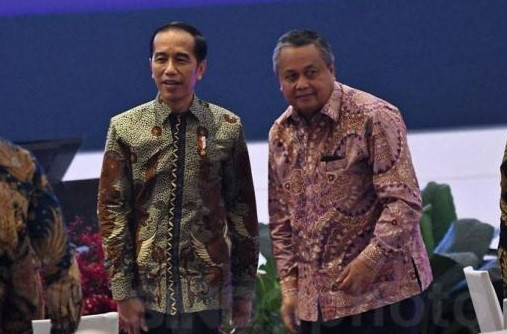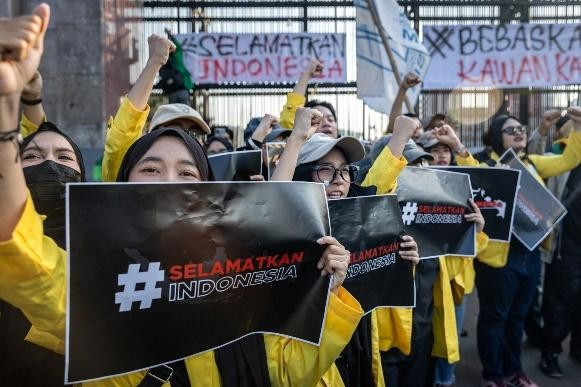Popular Reads
Top Results
Can't find what you're looking for?
View all search resultsPopular Reads
Top Results
Can't find what you're looking for?
View all search resultsIndonesian economy 2021: Maintaining stability toward recovery
The central bank forecasts improved stability toward recovery in the year ahead through close coordination between its monetary policy and the government’s fiscal policies.
Change text size
Gift Premium Articles
to Anyone
I
nvestor confidence has improved, as can be seen in the renewed inflow of Rp 48.6 trillion (US$3.4 billion) in foreign portfolios to the government securities (SBN) market recorded between April and November. Foreign reserves picked up at the end of October to reach $133.7 billion, higher than the pre-pandemic level. We are of the view that the current rupiah exchange rate is still fundamentally undervalued.
The stability and strengthening of the rupiah exchange rate is supported by a number of factors: (a) low and controlled inflation; (b) a low current account deficit of below 1.5 percent of gross domestic product (GDP) for the whole of 2020; (c) high interest rate differential between the domestic and overseas markets; (d) increased foreign exchange reserves; and (e) reduced risk premiums in line with lower uncertainty in the global and domestic financial markets.
The Bank Indonesia (BI) policy on lower interest rates and monetary relaxation has led to lower bank interest rates and better financial market stability, although the decline in lending rates remains modest. As we noted above, throughout the year, BI lowered the monetary policy rate by 125 basis points (bps) to bring the Bank Indonesia 7-Day Repo Rate (BI7DRR) to 3.75 percent. This BI policy interest rate is a record low in Indonesia’s economic history.
To encourage financing for business and the national economic recovery (PEN) program, BI also extended monetary stimulus through quantitative easing (QE) to a large number of banks. As of Nov. 20, the central bank has injected rupiah liquidity of around Rp 682 trillion, or nearly 4 percent of GDP, mainly through reducing the statutory reserve requirement.
The amount of QE by BI is the largest among emerging market economies (EMEs). To be more detailed, monetary operations were expanded through the provision of Rp 345 trillion in term repos to banks with underlying SBN and foreign exchange (FX) swaps. Monetary expansion was also conducted through the purchase of Rp 166.2 trillion in SBNs from the secondary market as part of the central bank’s rupiah exchange rate stabilization policy. In addition, BI cut the rupiah reserve requirement three times by a total of 300 bps this year, thereby increasing liquidity to around Rp 155 trillion.
Bank Indonesia’s moves to reduce interest rates and relax the monetary and macroprudential policies have helped maintain financial system stability. Ample liquidity in the banking sector was reflected in the high 30.65 percent ratio of liquid assets to third party funds (LA/TPF) in October.
Weak demand is the dominant factor that explains the 0.47 percent year-on-year (yoy) credit decline in October, despite the 12.21 percent yoy growth in bank deposits; i.e., weak demand is the primary cause of low credit growth. This is closely related to weak domestic demand and unfavorable business conditions due to the economic slowdown caused by the COVID-19 pandemic
To encourage the digital economy and finance as sources of economic growth, Bank Indonesia is accelerating the digitalization of the payment system under the 2025 Indonesian Payment System Blueprint (BSPI 2025).
The accelerated digital payment transformation implements the five visions in the BSPI 2025 we launched in May 2019 that are directed at encouraging: (i) integration of the national digital financial economy, particularly the retail and the micro, small and medium enterprise (MSME) sectors; (ii) banking digitization (open banking); (iii) interlinking digital banking with fintech; (iv) startup innovations in keeping with the principle of prudence; and (v) aligning national interests for cooperation in cross-border payment systems.
The campaign to expand the national and regional Quick Response Code Indonesian Standard (QRIS) has accelerated the digital financial economy, in particular retail trade and MSMEs. Since the August 2019 launch of the QRIS, the central bank has carried out a massive campaign to implement the QRIS as the sole standard in Indonesia both nationwide and regionally, especially for MSMEs, traditional markets and academia.
The digital transformation of Bank Indonesia has been thoroughly implemented in both policy and institutional areas so it becomes the leading digital bank. Digital transformation aims to turn BI into a data-driven institution with high analytics capability, digital business processes and international-standard information system services, as well as high data and digital literacy. In order to uphold good governance, all of these digital transformations are included in the 2025 BI Information System Master Plan.
National economic recovery is underway and will continue to progress in 2021 as well as in the medium term. As stated above, BI estimates that Indonesia’s economic growth will reach 4.8-5.8 percent in 2021, supported by increased export performance and private and government consumption, as well as increased investments from both capital expenditure and foreign capital inflows as a positive response to the implementation of the Job Creation Law. Macroeconomic and financial system stability will be maintained. Inflation will be controlled within the 2021 target of 3±1 percent, while the rupiah exchange rate will be stable and retain potential for strengthening further.
External stability will be maintained, with a balance of payments surplus supported by a low current account deficit of around 1.0-2.0 percent of GDP and foreign capital inflows, both foreign direct investment (FDI) and portfolio investment. Financial system stability is also improving, with a high capital adequacy ratio, low non-performing loans and 7.0-9.0 percent growth in deposits and credit in 2021. In the medium term, we project that Indonesia’s economic growth will continue to increase in the 5.5- 6.1 percent range, with low inflation in the 1.5-3.5 percent range.
In this regard, we are of the view mass vaccination and public compliance with the COVID-19 protocols as necessary conditions, along with the five following policies as moderate conditions: (i) opening productive and coronavirus-safe business sectors; (ii) accelerating fiscal stimulus; (iii) boosting credit from both the demand and supply sides; (iv) continuing monetary and macroprudential stimuli; and (v) digitalizing the economy and financial system, particularly MSMEs.
Vaccination and COVID-19 protocol compliance are requisite conditions for national economic recovery. It must be emphasized again that the epicenter of the problems we are facing is the COVID-19 pandemic.
A relatively large amount of fiscal stimulus is still needed to support national economic recovery. In the 2021 state budget, the government has budgeted for a fiscal deficit of Rp 1 quadrillion (5.7 percent of GDP) after a deficit of Rp 1.04 quadrillion (6.3 percent of GDP) in 2020. Of the total state spending of Rp 2.75 quadrillion, Rp 1.95 quadrillion has been allocated to central government expenditure.
Of this figure, a large portion amounting to Rp 1.68 quadrillion (86.3 percent) in the 2021 state budget has been allocated for strategic policies to accelerate economic recovery and economic transformation. We believe that the relatively large fiscal stimulus in the 2021 state budget will encourage national economic recovery in terms of both consumption and investment.
Synergy is necessary in boosting bank credit from the demand and supply sides, particularly in the productive and coronavirus-safe sectors. Demand for credit will increase in line with improving business conditions, particularly at large companies.
The monetary policy for stimulus will continue in 2021. Ensuring that the rupiah exchange rate remains stable in line with the currency’s fundamental value and market mechanisms, so it is conducive to national economic recovery, continues to be a major concern. Low interest rates and loose liquidity will be maintained until there are signs of increasing inflationary pressure.
Close coordination between BI’s monetary stimulus and the government’s fiscal stimulus continues to strengthen national economic recovery. In this regard, Bank Indonesia will continue to purchase SBNs from the primary market to finance the 2021 state budget as a non-competitive bidder at regular auctions or through private placement.
The close synergy between fiscal and monetary stimulus is a manifestation of BI’s strong commitment to working with the government to strengthen national economic recovery, even though this will have a large impact on the bank’s balance of payments deficit from 2021 and to the following years.
Macroprudential policy will remain accommodative so it continues to encourage credit expansion and financing for national economic recovery. BI will strengthen coordination with the Financial Services Authority (OJK) on macroprudential supervision.
***
The writer is the governor of Bank Indonesia. This is an abridged version of his monetary policy statement on Dec. 3 at the Bank Indonesia Annual Meeting 2020.










